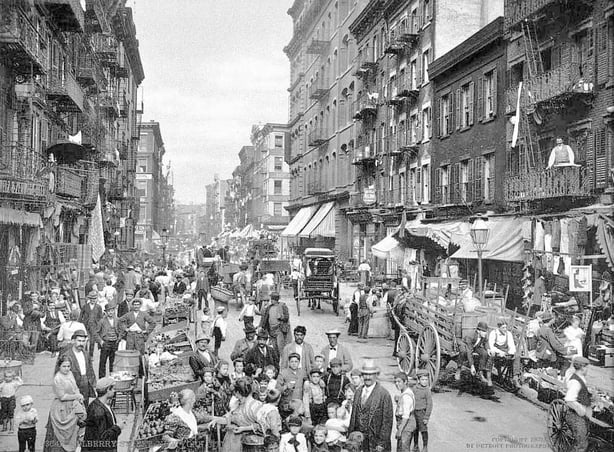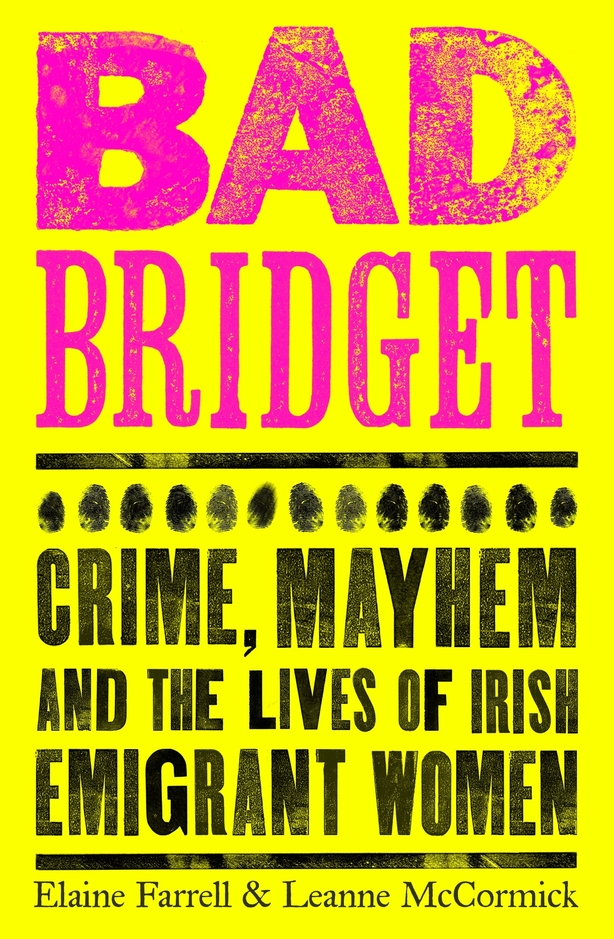We present and extract from Bad Bridget: Crime, Mayhem and the Lives of Irish Emigrant Women, the new book from Elaine Farrell and Leanne McCormick.
Ireland in the nineteenth and early twentieth centuries was not a good place to be a woman. Among the wave of emigrants from Ireland to North America were many, many young women who travelled on their own, hoping for a better life. Some lived lives of quiet industry and piety. Others quickly found themselves in trouble – bad trouble, and on an astonishing scale...
Elaine Farrell and Leanne McCormick, creators of the celebrated Bad Bridget podcast, have unearthed a world in which Irish women actually outnumbered Irish men in prison, in which you could get locked up for ‘stubbornness’, and in which a serial killer called Lizzie Halliday was described by the New York Times as ‘the worst woman on earth’. From sex workers and thieves to kidnappers and killers, these 'Bridgets' are young women who have gone from the frying pan of their impoverished homeland to the fire of vast North American cities. Bad Bridget is a work of social history and true crime, showing us a fascinating and previously unexplored world
'Sin and whiskey were written in the faces of every one of them', a journalist wrote on observing a group of women in the Toronto police court in May 1865. A ‘harder, more uncivilized and depraved looking set of abandoned women never appeared before the Court’ than this group of eleven women who had been arrested on Garrison Common. Seven of the women were Irish and they were all arrested for being drunk. The women were described as ‘stargazers’, a term used for sex workers who worked outside. They had been drinking and probably soliciting for trade from the soldiers in Fort York beside the Common.
Margaret McCormack was the eldest of the group at eighty years of age. She may not have been an active sex worker, but had been caught drinking and was arrested with the others. She found her situation in court hilarious and ‘with spasmodic fits of laughter enjoyed her elevation in the dock’. Julia Tracy, who was twenty years old, kept elbowing Margaret to get her to stop laughing, but her efforts had little effect and Margaret repeatedly dissolved into giggles. Twenty-year-old Maria Lee was apparently someone to whom ‘temperance, honesty and industry were a thing of the past’, and Elizabeth Stamford, who ‘with a red comforter around her head’ repeatedly shouted to the other women what was on the menu in jail that day, adding to the confusion and chaos. Catherine Glinn was ‘a frail one’, dressed in tattered rags, and 21-year-old Margaret Howard promised the magistrate that she would behave herself in future. This group of women were sent to prison together for sixty days.
That May Saturday night in Toronto was clearly a busy one for Irish women. Charged alongside the seven Irish women who had been arrested at Fort York were another four Irish women who had been picked up in the city. Among them was Margaret Sherlock, another court regular, who went ‘astray with a glass of whiskey’ and was so drunk that she could not find her way home. The journalist joked that ‘She will have a free ride to the gaol – her proper home – and lodging for two months.’ Sarah King, another eighty-year-old suspect with a bad reputation, was ill and requested that the judge sentence her to a few months in prison, evidently seeing it not as a punishment but as a chance to get well again.
George Denison, writing about his experiences as a magistrate in the Toronto police court from 1877, described how the Irish 'added very much to the humour of the proceedings in the Court'. During his time as a magistrate, he likely encountered individuals like these eleven Irish women, or like Letitia Dixon, an ‘old offender’, who had been in the court only a few days before. She was considered by the court reporter to be ‘one of the drunkest looking citizens who could be picked up’. Alongside her was 24-year-old Ellen Price, who cut a striking figure with a red feather in her hat. As she left court to begin her sixty-day sentence, she burst into a rendition of ‘The Rocky Road to Dublin’, suggesting that she might still have been feeling the effects of her night’s spree. Singing was also part of Eleanor David’s conviction. This so-called ‘virago’ had been drunkenly singing in front of one of Toronto’s music halls when stopped by a policeman a few months before Ellen Price’s arrest. She refused to move and he was compelled to drag her along the street until reinforcements arrived to carry her to the police station. Eleanor David told the policeman that she loved whiskey and ‘as long as there was a drop of Irish blood left in her body she would drink it’. She declared that ‘she wouldn’t stop until the sods of the valley covered her’.

When the Toronto Globe began to include the nationalities of offenders in reports of court proceedings in the spring of 1865, it became apparent that many of the women in the courtroom were Irish-born, and most of them had been charged with offences relating to alcohol. For the Irish in North America, both male and female, alcohol-related offences were the most common cause of conviction. In 1859, 58.8 per cent of all Irish convictions in the New York Courts of Special Sessions were for being drunk or for disorderly conduct. By 1876 the Irish were no longer the largest ethnic group arrested and prosecuted for most offences, but they continued to top the table for intoxication and disorderly conduct offences. In Boston too the rapid increase in arrests for drunkenness in the 1840s was blamed on the influx of Irish immigrants and the ‘Irishman’s appreciation of spirituous drink’.
Did the Irish really drink much more than everyone else? Archbishop Lynch, the Catholic Archbishop of Toronto, considered that they were just unusually susceptible to the effects of alcohol. He noted in 1875: ‘the Irish people do not drink more than others; but their blood is so hot, and their nature so fervid and exuberant, that adding to it the fire of alcohol the Irishman becomes more unreasonable than men of other and more plodding temperaments’.9Irish drinking practices were also thought to contribute to their high arrest rate. A New York Times journalist considered that Irish men’s fondness for drinking in bars and saloons resulted in their drunkenness; German immigrants also consumed considerable amounts of alcohol, but typically drank in more family-friendly social settings with their wives and children. According to historian Kevin Kenny, Italian immigrants’ tendency to consume food alongside alcohol rendered them less susceptible to charges of drunkenness than Irish men drinking in bars and saloons.

Bad Bridget: Crime, Mayhem and the Lives of Irish Emigrant Women is published by Penguin.

